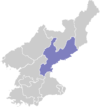Sudong County: Difference between revisions
Appearance
Content deleted Content added
Rescuing 0 sources and tagging 2 as dead.) #IABot (v2.0.9.5) (Nintendofan885 - 18070 |
-tong → -dong ; -li → -ri |
||
| Line 70: | Line 70: | ||
* Sudong-dong |
* Sudong-dong |
||
* Tŏksa-dong |
* Tŏksa-dong |
||
* Un'gok- |
* Un'gok-dong |
||
* Wŏn'gŏ-dong |
* Wŏn'gŏ-dong |
||
* Changryang-ri |
* Changryang-ri |
||
* Chukchŏl- |
* Chukchŏl-ri |
||
* Ch'ŏnsŏng-ri |
* Ch'ŏnsŏng-ri |
||
* Ch'ŏn'ŭl- |
* Ch'ŏn'ŭl-ri |
||
| valign="top" | |
| valign="top" | |
||
* Ch'ukchŏl- |
* Ch'ukchŏl-ri |
||
* Hoep'yŏng-ri |
* Hoep'yŏng-ri |
||
* Ryongp'yŏng-ri |
* Ryongp'yŏng-ri |
||
| Line 84: | Line 84: | ||
* Sŏngnae-ri |
* Sŏngnae-ri |
||
* Sŏngnam-ri |
* Sŏngnam-ri |
||
* Susal- |
* Susal-ri |
||
* Unhŭng-ri |
* Unhŭng-ri |
||
* Unsal- |
* Unsal-ri |
||
|} |
|} |
||
Revision as of 13:16, 10 April 2024
Sudong County | |
|---|---|
| Korean transcription(s) | |
| • Hangul | 수동군 |
| • Hanja | 水洞郡 |
| • Revised Romanization | Sudong-gun |
| • McCune–Reischauer | Sudong kun |
 Map of South Hamgyong showing the location of Sudong | |
| Country | North Korea |
| Province | South Hamgyong |
| Administrative divisions | 6 tong, 14 ri |
| Area | |
| • Total | 783.4 km2 (302.5 sq mi) |
| Population (2008)[1] | |
| • Total | 95,716 |
| • Density | 120/km2 (320/sq mi) |
Sudong County is a county in South Hamgyŏng province, North Korea. It was formed from part of Kowŏn County in December 1990.[2]
Sudong is the site of a major coal seam first discovered in 1918.[3] The P'yŏngra Line of the Korean State Railway passes through the district.
Administrative divisions
Sudong is divided into 6 tong (neighbourhoods) and 14 ri (villages):
|
|
Transportation
Sudong-gu has a trolleybus line opened in 1979 running within this district,[4] linking residential areas to Kowon mine.[5] The line opened in 1979, with a number of second hand Chollima 9.11 trolleybuses used to serve the line initially.[6] The line appears to no longer have any trolleybuses.
Kowon Tangwang Line runs to this district from Tunjon station, serving the colliery.[7]
See also
Notes
- ^ North Korea: Administrative Division
- ^ "행정구역 개편 일지". NKChosun.com. 2006-04-05. Archived from the original on 2006-11-02. Retrieved 2006-11-08. See also 고원군의 연혁[permanent dead link]
- ^ 고원-문천탄전 (in Korean). Doosan Encyclopedia/Naver. Retrieved 2006-11-08.[permanent dead link]
- ^ "민추본". www.unikorea.or.kr. Retrieved 2021-02-22.
- ^ "북한지역정보넷". www.cybernk.net. Retrieved 2021-02-22.
- ^ "Обзор транспорта Северной Кореи". www.gruzovikpress.ru. Retrieved 2021-04-20.
- ^ Kokubu, Hayato; 国分隼人 (2007). Shōgun sama no tetsudō : Kitachōsen tetsudō jijō. Tōkyō: Shinchōsha. ISBN 978-4-10-303731-6. OCLC 140100407.

